Matador Network's Blog, page 40
May 27, 2025
The Best Hotels Near Kansas City’s Arrowhead Stadium for Soccer Fans

Kansas City is set to host six matches during the 2026 FIFA World Cup, including four group-stage games and a quarter-final on July 11. Arrowhead Stadium — officially renamed GEHA Field at Arrowhead Stadium — is home to the Kansas City Chiefs and sits in the Truman Sports Complex in East Kansas City. This area is not particularly pedestrian-friendly, and there are few decent hotel options nearby. Fortunately, there are plenty of great places to stay within a short drive or direct transit link.
A few downtown hotels offer quick access via the KC Streetcar and bus connections through East Village, while others near Overland Park and the Plaza are good options if you’re planning to drive or take a rideshare. And unlike many other World Cup host cities, Kansas City is already well set up for game-day transit, with shuttles running from many hotels to the stadium.
From walkable stays near public transit to hotels offering direct shuttles to Arrowhead, these are the best places to stay in Kansas City for fans heading to the World Cup.
We hope you love the hotels near Arrowhead Stadium we recommend! Just so you know, Matador may collect a small commission from the links on this page if you decide to book a stay. Listed prices are accurate as of the time of publication.
The best hotels near hotels near Arrowhead StadiumAmbassador Hotel Kansas City
Photo: Booking
Location: 1111 Grand Blvd, Kansas CityHow far from the stadium: 14-minute drive, or 30-minutes on public transportPrice: From $161 per nightIf you want to stay downtown during the World Cup, the Ambassador Hotel puts you close to just about everything — the KC Streetcar, the Power & Light District, the T-Mobile Center, and a direct bus route to Arrowhead from nearby East Village. The hotel sits in a restored 1920s neoclassical building on Grand Boulevard and feels quieter than the larger hotels in the area. Rooms are well-sized and simply styled, and many offer views over the city. You’ll also be within walking distance of several fan zone hotspots, including KC Live! Block, where match screenings and watch parties are expected to draw big crowds. Back at the hotel, Lonnie’s Reno Club — the downstairs jazz lounge — runs dinner-and-show evenings with a fixed menu and live performances, while The American Reserve serves hearty mains like espresso-rubbed pork shoulder and Chilean sea bass.
BookBest Western Plus Kansas City Sports Complex Hotel
Photo: Booking
Location: 4011 Blue Ridge Cut Off, Kansas CityHow far from the stadium: 15-minute walkPrice: From $72 per nightYou won’t find a shorter walk to Arrowhead at this price. The Best Western is a budget-friendly option about 15 minutes from the stadium on foot — perfect for a quick stay if you’re catching a match and don’t need anything fancy. Rooms are straightforward, with handy extras like a mini fridge, coffee maker, and daily breakfast included. There’s also a small gym and an on-site restaurant, the Boulevard Grill, which serves casual American fare in the evenings. It’s basic, but availability this close to the stadium won’t last long during the World Cup.
BookHotel Kansas City — The Unbound Collection by Hyatt
Photo: Booking
Location: 1228 Baltimore Ave, Kansas CityHow far from the stadium: 15-minute drivePrice: From $153 per nightHotel Kansas City has been flagged as a potential team base camp for the World Cup, and ranks among the top four-star stays in the city. Less than 15 minutes from Arrowhead by car, it occupies a 1920s Gothic Revival building that once housed a private social club, with original features like walnut paneling, vaulted ceilings, and stained glass still intact. Room layouts vary, but many have excellent views, vintage-inspired furnishings, and thoughtful details that mirror the building’s early 20th-century architecture. It’s in the heart of downtown near the Power & Light District, putting bars, restaurants, and public transit within walking distance. The on-site restaurant, The Town Company, is led by a James Beard-nominated team and regularly turns up on local “best of” lists. There’s also a sleek lobby bar, a grab-and-go café, and a performance venue in the basement that hosts DJ nights, drag shows, and live music. Since some World Cup teams are expected to train at the nearby KC Current Training Facility, don’t be surprised if you end up sharing an elevator with a player or two.
BookHotel No Vacancy
Photo: Booking
Location: 1717 Wyandotte St, Kansas CityHow far from the stadium: 15-minute drive, or one-hour on public transportPrice: From $165 per nightWith just eight rooms, No Vacancy is one of the most distinctive five-stars in Kansas City — intimate, full of personality, and refreshingly untraditional. If you want a boutique stay that feels personal, playful, and totally separate from chain hotel sameness, this would be my choice. Set on the second floor of a building in the Crossroads Arts District, about a 15-minute drive from Arrowhead, there’s no front desk, and each room is completely different — some with bamboo barstools or disco balls, others with clawfoot tubs or kitchenettes. Exposed brick, tall ceilings, and big windows give the whole place a sense of space and light, and the communal parlor connects all the rooms and opens onto a second-story courtyard, which gets sun most of the day and is only available if you book out the whole hotel. That’s an option, by the way — and one worth exploring if you’re heading to the tournament with a crew and want to hold your own event.
BookLoews Kansas City Hotel
Photo: Booking
Location: 1515 Wyandotte St, Kansas CityHow far from the stadium: 15-minute drivePrice: From $188 per nightLoews Kansas City is one of the most well-equipped hotels near Arrowhead — and if you’re planning your stay around match days, it’s got a few perks that stand out. The hotel offers a Tailgate Rate package available during major sporting events that includes parking, a $25 food and beverage credit, and late checkout. With 800 rooms, you’re unlikely to have trouble finding space, and the location puts you just a few blocks from the Power & Light District and the KC Streetcar. There’s a lap pool, full-service spa, and a wraparound balcony at The Stilwell — the hotel’s main restaurant — that overlooks downtown. Other dining options include Horsefeather Social, a seasonal rooftop bar, and Red Wheat Baking Co., a grab-and-go café that’s handy on match mornings. Rates vary depending on match dates and packages, but for fans looking for comfort, convenience, and match-focused perks, this one’s worth bookmarking.
BookSheraton Kansas City Hotel at Crown Center
Photo: Booking
Location: 2345 McGee St, Kansas CityHow far from the stadium: 15-minute drivePrice: From $198 per nightSheraton Kansas City at Crown Center is one of the more practical hotel options near Arrowhead — and while shuttle service isn’t guaranteed, it has been offered in the past on game days, so it’s worth confirming ahead of your stay. It’s a 15-minute drive to the stadium, and being directly connected to Crown Center means you’re steps from shops, restaurants, and Union Station. You’ll also be a short walk from the KC Streetcar, which links up with downtown fan zones like Power & Light. Rooms are straightforward, with neutral palettes and modern art. Spectators, the on-site bar and grill, serves classic pub food alongside Kansas City-style barbecue. Rates vary by date, especially around big fixtures, but location and convenience make this one of the better downtown low to mid-range bases.
BookSheraton Overland Park Hotel at the Convention Center
Photo: Booking
Location: 6100 College Blvd, Overland Park, KS 66211How far from the stadium: 18-minute drivePrice: From $132 per nightThere’s a chance this will be one of the World Cup team base camps, thanks to its proximity to the Sporting KC Training Center. Sheraton Overland Park sits about 18 minutes from Arrowhead by car, in a part of town that’s more suburban than city center — meaning quieter evenings and plenty of parking. It’s connected to the Overland Park Convention Center, so it’s worth checking the event calendar in case your fixture lines up with a big conference. OP1906, the hotel’s restaurant and bar, serves comfort food and has an outdoor patio if you’re sticking around for dinner.
BookThe Oread Lawrence
Photo: Booking
Location: 1200 Oread Ave, LawrenceHow far from the stadium: 50-minute drivePrice: From $111 per nightSome World Cup teams are expected to stay at The Oread Lawrence while training at the University of Kansas, which makes this hilltop hotel one of the likeliest places to spot players away from the stadium. The drive from the hotel to Arrowhead takes about 50 minutes, and the property sits right next to the University of Kansas. The hotel is steps from David Booth Memorial Stadium and a few blocks from downtown Lawrence, with college bars, coffee shops, and late-night food spots within walking distance. There’s no direct public transport to Arrowhead, so a car is essential. Rooms are functional and reasonably priced, and the rooftop bar — The Nest — has sweeping views of campus and the Kaw River Valley. Rock & Hawk, the hotel’s main bar and grill, serves burgers, wings, and an extensive list of craft beers and cocktails. If you’re considering staying here, you’re probably planning a road trip, or a mega-fan hoping to run into a team in the lobby. 
Where to Play, Eat, and Stay in Boston During the World Cup Matches

As one of the 11 US host cities of the 2026 FIFA World Cup, Boston is gearing up to welcome soccer fans from around the world. The Massachusetts capital is no stranger to large sporting events, with plenty of history and interesting neighborhoods to explore, plus a number of character-filled bars to watch the games in. If you’re planning on traveling for the event, you’ll want to know where to eat, play, and stay to soak up the electric atmosphere of the world’s greatest soccer tournament — even if you don’t have tickets to the World Cup itself.
It’s not Boston’s first major sporting eventThis is not the first time that Boston has hosted a FIFA championship. It first welcomed the FIFA World Cup USA in 1994, then the FIFA Women’s World Cup in both 1999 and 2003. In 2026, Boston will host seven different World Cup games at Boston Stadium (also known as Gillette Stadium), where the Patriots NFL team usually plays. Foxborough, where the stadium is located, is relatively easy to get to from the heart of Boston, either by an hour-long car ride or a 45-minute train ride from South Station to Mansfield and a quick Uber ride from there.
Though somewhat removed from the stadium, downtown Boston is a great place to explore between games. To get you in the World Cup mood, here are some soccer-themed ways to spend time in Boston.
We hope you love the spaces and stays we recommend for the FIFA World Cup! Just so you know, Matador may collect a small commission from the links on this page if you decide to book a stay.
Sporty things to do in BostonBoston is one of America’s most historic and walkable cities, with centuries-old landmarks woven into the fabric of its vibrant neighborhoods. Most visitors will want to explore iconic sites like the Freedom Trail, Fenway Park, and Quincy Market. But if you’re visiting for the World Cup matches in Boston, the activities below lean a little more athletic—whether that means catching a game-day watch party or kicking back with locals at a waterfront pub.
See the Sports Museum Boston
Photo: Library of Congress/Public Domain
Boston is nicknamed “The City of Champions,” thanks to its storied sports teams that have dominated the major leagues of baseball, basketball, football, hockey, and, yes, even soccer. The city is also home to some of the most passionate sports fans in the nation, so you can expect Boston to be buzzing with contagious energy in the time around the World Cup. Make sure to visit The Sports Museum inside TD Garden to learn more about the city’s sports history. In 2026, the museum will run an exhibit that celebrates the World Cup and how it relates to the history of New England, shining a spotlight on local World Cup competitors like Arnie Oliver, a member of the first-ever US team in the 1930 World Cup who hailed from New Bedford, Massachusetts. Tickets start around $16 for adults.
The Sports Museum: TD Garden, 100 Legends Way, Boston, MA 02114
Support Boston’s hometown teams
Photo: New England Revolution
Starting in 2026, Boston will be home to its first professional women’s soccer team. So while you’re in the area, catch the new Boston Legacy FC in action. The city also has a professional men’s team, the New England Revolution. Since both teams play in the same stadium where the World Cup is set to take place, there may be some venue changes, but keep an eye on the schedule if you want to get even more of a soccer fix during your time in Boston. Tickets for Revolution games usually start around $42 per person, including fees.
Explore the European North End
Photo: Marcio Jose Bastos Silva/Shutterstock
Boston’s Little Italy neighborhood is called the North End, and its narrow, cobbled streets feel straight out of Europe. It’s also home to a number of European immigrants, so you can expect the neighborhood to be particularly amped up for the Boston World Cup matches.
While you’re in the city, tour the North End’s historic sites (including the church where Paul Revere started his famous midnight ride), hop between restaurants and sports bars to watch the games, or walk along the nearby Freedom Trail that takes you past the city’s major historic sites.
Where to Eat and Drink in Boston during the World CupBoston isn’t just a city of die-hard Red Sox and Celtics fans — it’s also home to a passionate soccer community. And with the city deep pub culture and ongoing sports obsession, you’ll want to keep the spots below on your radar for game day.
Caffè dello SportView this post on InstagramA post shared by Caffe dello Sport (@caffe_dello_sport)
In the North End, Caffè dello Sport is a European-style cafe where soccer is always on TV and locals are always sitting outside, sipping espressos and chatting in Italian. The cafe serves a simple menu of pastries, panini, and gelato, but it’s also right around the corner from some of the North End’s best restaurants, like Carmelina’s farther along Hanover Street. It’s also a five-minute walk from the North End location of Regina Pizzeria, Boston’s most famous brick-oven pizza joint that has been around since the early 20th century.
Caffe dello Sport: 308 Hanover St, Boston, MA 02113
The BansheeView this post on InstagramA post shared by Banshee Pub (@bansheeboston)
The neighborhood of Dorchester, between downtown Boston and Foxborough, is home to an Irish sports pub called The Banshee that shows European and American soccer games throughout the year. It’s the perfect place to grab a pint and encounter fellow soccer fans. It also shows rugby and hockey games, but soccer is the big draw. Depending on the day, you’ll find English Premier League, Scottish Premier League, Serie A (Italy), and La Liga (Spain) matches, plus any other major international futbol game.
The Banshee: 934 Dorchester Ave, Boston, MA 02125
Luciano’s RestaurantView this post on InstagramA post shared by Vincent Errichetti (@tasteofmassachusetts)
Just off 495 outside of Foxborough, Luciano’s is a classic Italian restaurant that’s an ideal place for a meal when on your way to or from Gillette Stadium for the World Cup games. It’s owned by award-winning Chef Luciano himself, who grew up outside of Rome and attended the Culinary Institute of Italy, so you can expect authentic Italian fare and a welcoming atmosphere.
Luciano’s Restaurant: 800 Washington St, Wrentham, MA 02093
The Phoenix LandingView this post on InstagramA post shared by The Phoenix Landing (@phoenixlanding_)
As one of Boston’s official Liverpool bars, The Phoenix Landing in Cambridge is a regular meeting place for soccer fans and a lively place to catch a game. The bar has a full food menu in addition to drinks and is open until 2AM throughout the week, meaning it’s likely one of the spots where soccer fans will end up spending their evenings during the tournament.
The Phoenix Landing: 512 Massachusetts Ave, Cambridge, MA 02139
The Greatest BarView this post on InstagramA post shared by The Greatest Bar (@thegreatestbar)
Head to The Greatest Bar near North Station, a venue known for its soccer watch parties. This spot also offers a dose of local culture, doubling as a museum of sorts that honors Boston sports, hung with photos of the city’s most decorated athletes and sports teams. It also has a skee-ball lounge, complete with league tournaments, if old-school games are your thing.
The Greatest Bar: 262 Friend St, Boston, MA 02114
A.T. O’Keefe’s Irish PubView this post on InstagramA post shared by A.T. O’Keeffe’s (@a.t.okeeffes)
A.T. O’Keefe’s Irish Pub claims to be “The Oldest Sports Bar in America,” and has a cozy atmosphere, hearty pub food menu, and impressive bourbon selection. At half time, step outside and take a walk along the Charles River Esplanade around the historic Back Bay neighborhood. The menu is heavy on the usual pub food, but with a few elevated twists, like truffle mac and cheese and house-made Irish Curry.
A.T. O’Keefe’s Irish Pub: 911 Boylston St, Boston, MA 02115
Where to stay for the Boston World Cup Matches
Photo: Booking.com/The Godfrey Hotel Boston
Boston doesn’t hurt for amazing hotels or home rentals, many of which are in the city’s historic neighborhoods and waterfront areas. A few of the best places to book ahead of time for Boston World Cup matches are below, or you can explore our full list of the best hotel’s near Gillette Stadium and beyond. It’s advisable to book your hotels as pafar in advance as possible — the city is going to be busy.
We hope you love the spaces and stays we recommend! Just so you know, Matador may collect a small commission from the links on this page if you decide to book a stay. Listed prices are accurate as of the time of publication.
The GodfreyIf you want to stay in the city but avoid the nightmarish traffic getting to Foxborough, look for accommodation around South Station. The Godfrey is an elegant boutique hotel in a pre-war building about a 10-minute walk from the station. It has modern rooms, some of which offer direct views of Downtown Crossing (one of Boston’s liveliest pedestrian areas). Rooms start around $180 per night but can vary wildly.
Book NowBoston Harbor HotelThough a slightly further walk from South Station, the Boston Harbor Hotel is on the water and offers easy access to nearby attractions and restaurants. That includes the scenic Harborwalk, and landmarks like the indoor food marketplace Faneuil Hall or the New England Aquarium. Rooms start around $480 per night but can be much pricier in the summer.
Book NowRenaissance Boston Patriot Place HotelIf you don’t want to stay in the city, there are plenty of hotels in Foxborough itself, like the Renaissance Boston Patriot Palace Hotel. This Marriott property is so close to the stadium you can practically look out on the field from your room, and has amenities like an on-site pool, fitness area, and restaurant. Rooms start around $200 per night. 
Where to Eat, Play, and Stay for the Kansas City 2026 World Cup Matches

Soccer may not be one of the first things most folks associate with Kansas City — but it should be. This Midwestern metropolis has quietly but quickly become the beating heart of American soccer over the past 25 years, turning into a city that doesn’t just watch the sport, but lives and breathes it. Soccer shows up everywhere in KC, from the obvious (the packed stands at Sporting KC games and the fan gear in every shop across town) to the more subtle. Expect even casual dinner conversations to veer into match analysis) during the soccer season.
That same all-in energy spills over into just about everything else Kansas City does. Yes, it’s a sports town through and through, but it’s also well-known for a few other things: barbecue that borders on religious devotion, a colorful and storied jazz scene, and a healthy dose of that famous ‘Midwest nice.’ Spend more than a few hours there, and you’ll see how KC’s passions — sports, food, music and hometown pride — intertwine in surprising ways.
As Kansas City prepares to take the global stage in 2026, that pride will be on full display. The city is home to not one but two professional outdoor soccer teams: Major League Soccer’s Sporting Kansas City and the Kansas City Current of the National Women’s Soccer League, plus the Kansas City Comets, a Major Arena Soccer League team. The Heartland Soccer Association, the country’s largest youth league and one of the strongest pipelines for young talent in the US, also calls KC home.
So perhaps it’s no wonder KC earned the nickname “Soccer Capital of America” The title speaks to more than its championship teams or impressive venues. It’s one of the most inclusive and enthusiastic soccer cities in the country, with European-level fandom and support. Crowds routinely pack the Power & Light District to cheer on international matches, to the point where it’s become a go-to cutaway during televised World Cup games when the US scores.
Add to all that Kansas City’s central location smack-dab in the middle of the country, world-class stadiums, and a pioneering fare-free public transit system, and it’s easy to see why it was tapped as one of the hosts for the world’s biggest sporting event. With six World Cup matches on the schedule, including a quarterfinal, KC was practically designed to step into the spotlight.
Here’s what to do if you’re heading to any of the Kansas City World Cup matches.
Top things to do in Kansas CityBetween Kansas City World Cup games, visitors can easily explore Kansas City — for free, no less — via the KC Streetcar. With convenient stops throughout the city’s entertainment districts, fans can ride from Country Club Plaza through the Crossroads Arts District, Power & Light and River Market, ending up near CPKC Stadium in the Berkley Riverfront neighborhood. For World Cup games, RideKC’s 47 Broadway line takes fans directly to Arrowhead Stadium. (Again, free of charge).
Explore the Kansas City Power & Light District
Photo: Vineyard Perspective/Shutterstock
This 12-block entertainment district in the center of downtown has dozens of dining, entertainment and shopping options at virtually any hour. That includes >No Other Pub, the official home of Sporting Kansas City watch parties. Make your first stop Rally House, where you can stock up on Sporting fan gear. The KC Live! block, affectionately dubbed “Kansas City’s living room,” anchors the district, with two stories of restaurants, bars, beer gardens and nightlife hotspots, as well as a large covered, open-air courtyard with a concert stage. The space will host numerous pop-up events and watch parties during the World Cup, in addition to the wildly popular Miller Lite Hot Country Nights concert series every Thursday. Sports fans shouldn’t skip the hands-on College Basketball Experience and National Collegiate Basketball Hall of Fame, across the road from KC Live!
Power & Light District: 13 Grand Blvd, Kansas City, MO 64106
Dive into the Negro Leagues Baseball Museum
Photo: James Kirkikis/Shutterstock
Keep the sports theme going with a visit to the Negro Leagues Baseball Museum, celebrating Kansas City’s baseball history — or, more specifically, celebrating the Negro National League and the legendary Kansas City Monarchs. The museum sits in the historic 18th & Vine Jazz District, just two blocks from the exact spot where baseball player and manager Andrew “Rube” Foster created the Negro National League in 1920. Beyond the history of baseball itself, the museum also tackles the ballplayers’ ugly realities, including racism and segregation in both the sport and their daily lives.
Negro Leagues Baseball Museum: 1616 E 18th St, Kansas City, MO 64108
Get goofy at the Museum of BBQ
Photo: Museum of BBQ
Kansas City is synonymous with barbecue, and fully embraced the title with the April 2025 opening of the world’s first museum dedicated to it. Part photo op and part educational experience, the immersive museum gives visitors an in-depth look at the food’s surprisingly complex history and culture, exploring its various elements and famous BBQ regions including the Carolinas, Memphis, Texas and rival St. Louis. Notably, the museum is inside the Crown Center, which is also home to Hallmark’s headquarters and visitor center, as well as dozens of other family-friendly attractions. Tickets are only $10.
Museum of BBQ: 2450 Grand Blvd Ste 231, Kansas City, MO 64108
Where to eat and drink during the Kansas City World CupNo Other PubView this post on InstagramA post shared by No Other Pub by Sporting KC (@nootherpub)
This popular sports bar is the official home for Sporting KC watch parties and bound to be one of the best places to catch KC’s World Cup matches. Stop in for happy hour food and drink specials (4-7 PM Thursday and Friday), and $4 domestic drafts and $5 wells when you wear Sporting gear on game days.
No Other Pub: 1370 Grand Blvd, Kansas City, MO 64106
Strange Days Brewing CompanyView this post on InstagramA post shared by Strange Days Brewing Co. (@strangedaysbeer)
This brewery’s setup is awesome inside and out, with arcade games, eclectic decor (picture: a whole wall of mismatched retro TVs), and, most importantly for soccer fans, plenty of seating. Strange Days hosts watch parties for both men’s and women’s leagues, with opening hours that match obscure overseas start times.
Strange Days: 316 Oak St, Kansas City, MO 64106
KC Bier Co.View this post on InstagramA post shared by Kansas City Bier Company (@kcbierco)
A local go-to for Bundesliga (German league) games, this beloved brewery welcomes all types of soccer fans. The biergarten, bierhall, and authentic German-style beer and snacks like the Bavarian pretzels are perfect accompaniments for Cup games.
KC Bier Co.: 310 W 79th St, Kansas City, MO 64114
Pitchside CoffeeView this post on InstagramA post shared by Kansas City Current (@kccurrent)
Fuel your love of soccer and caffeine at this coffee truck, owned and run by six KC Current players: Kristen Hamilton, Elizabeth Ball, Hailie Mace, Vanessa DiBernardo, Mallory Weber, and Desiree Scott. The truck hosts pop-up events around the city, makes regular appearances at First Fridays in the Crossroads Arts District, and serves fans at CPKC Stadium on game days.
Try BBQ across the cityView this post on InstagramA post shared by Arthur Bryant's (@arthurbryantskc)
With its world-class barbecue scene, sampling at least a couple of places is a must. Start with burnt ends, Kansas City’s signature creation, at Gates Bar-B-Q or Q39. The pulled pork from the iconic gas station location of Joe’s Kansas City Bar-B-Que and brisket from Arthur Bryant’s are also worthy of a detour.
Where to stay during the Kansas City World Cup matches
Photo: Mihai_Andritoiu/Shutterstock
We hope you love the spaces and stays we recommend! Just so you know, Matador may collect a small commission from the links on this page if you decide to book a stay. Listed prices are accurate as of the time of publication.
Origin Kansas City RiverfrontOpened in late 2024 steps from CPKC Stadium, this pet-friendly boutique hotel offers guests complimentary bicycle rentals, an on-site restaurant and bar (Show Pony), and a location within walking distance of the streetcar. There’s also a Charlie Hustle retail location, so you can nab one of those iconic KC heart shirts. Rates start around $159 per night in the summer.
Book NowCrossroads HotelCrossroads Hotel is Missouri’s only Michelin-keyed hotel and occupies a former Pabst Brewing Depot in the historic Crossroads Art District. Expect industrial-chic vibes, with exposed brick and beams throughout the building, plus a perpetually buzzing cafe, Italian restaurant, and rooftop bar, called Percheron. Rooms start around $225 per night in the summer.
Book NowHotel Kansas CityOld meets new at Hotel Kansas City, a Gothic Revival–style luxury downtown hotel that was once the ultra-exclusive Kansas City Social Club, hosting the likes of Harry Truman and Dwight D. Eisenhower. Guests can sip cocktails in the lobby bar or in the speakeasy-esque Nighthawk, or score a coveted reservation at The Town Company, helmed by a James Beard-nominated chef. Rates start around $200 per night in the summer.
Book NowAn Airbnb steps from the stadiumIf a home rental is more your thing, this bright and updated home near the stadium has four bedrooms and three bathrooms, plus a roomy kitchen and free parking. It’s loaded with everything from coffee to throw pillows and has a rare five-star rating. As with all Airbnbs in World Cup cities, the owners advise booking ASAP if you’re planning to visit for the event.
 Book NowMore like thisRoad TripsThe Most Epic Road Trip Through America’s Heartland
Book NowMore like thisRoad TripsThe Most Epic Road Trip Through America’s Heartland
May 26, 2025
This Historic San Diego Hotel Is a Must-Stay for Modern Travelers

Pulling up to Hotel del Coronado, I felt the history. Celebrities, past presidents, and important members of society have all crossed the threshold into the lobby to check into the same property I did during a recent trip to San Diego. Marilyn Monroe filmed Some Like It Hot at the hotel in the late 1950s. President Franklin D. Roosevelt and Thomas Edison are among the other big names who’ve walked its halls, which were originally built in the 1880s.
As you check into the main building — now one of several areas (or “neighborhoods”) on the property where you can stay — it’s immediately apparent that the hotel’s design pays homage to its history, from the old-school room key tassels lining the back of reception, to the stained-glass windows letting in beams of light, to the open concept showing off each floor. Even the wallpaper hints at historical facts. But Hotel del Coronado is no relic of the past. Here’s what to expect.
Getting to know the neighborhoods: Accommodations at Hotel del Coronado
Photos: Jessica Kelly
Hotel del Coronado has five so-called neighborhoods: The Victorian (aka the original building), The Cabanas (located near the pool and beach), The Views (facing the Pacific Ocean), Beach Village (a group of beachfront accommodations), and Shore House (the newest residential-style addition). I stayed in one of the Shore House’s newer villas, about three years old, which range from one to three bedrooms and include a wide variety of accessible accommodations.
When I stepped inside, I noticed the well-equipped kitchen first. It had a full-sized refrigerator and freezer, dishware and cooking supplies, wine glasses, and even a wine fridge. This was just one example of how the villa was outfitted for guests who’d like to stay a while — or revel in homestyle comfort for any length of stay. The room also had a washer and dryer complete with detergent and fabric softener. When you’re coming back from the beach with a pair of pants that got smacked by an ocean wave, it’s nice to have the option to do a quick load of laundry.
My villa also had a living room area with a TV and two separate entrances to the balcony. As I walked into the next room, I noticed that the closet was stocked with cozy robes and slippers, which are sure to come in handy after hopping out of the rainfall shower or massive soaking tub, where guests can relax with the bath salts provided.
Classes, tours, and more: Activities and amenities at Hotel del Coronado
Photos: Jessica Kelly
On arrival, the hotel’s guest service team gives out a schedule with information about all of the property’s upcoming programming, ranging from beach bonfires and live music to holiday-specific happenings depending on when you visit. Some offerings are included while others are available for a small fee, usually around $35.
In addition to workout classes like spinning, high-intensity interval training, and yoga, the hotel also facilitates surf lessons through the Jamie O’Brien Surf Experience, which operates from the resort’s private beach. Professional surfer Jamie O’Brien started a series of surf schools in Hawai’i — Hotel del Coronado’s is the only one located on the mainland.
After a day riding waves, the Spa & Salon at The Del offers a range of massages, facials, and other body treatments, including those that capitalize on the hotel’s beachy setting like the Stimulating Seaweed and Lavender Body Buff and the Detoxifying Seaweed Leaf Wrap. These comeplement a suite of prenatal treatments that are perfect for babymooners.
The hotel also hosts activities with local Southern California experts that offer glimpses into the property’s legacy, including history tours that dive into the hotel’s Victorian architecture, ghost tours that center the story of a woman named Kate Morgan who died mysteriously on the property in 1892 and set off a series of paranormal reports, and Ice House Museum tours. Located on site, the museum features fun artifacts that chronicle the hotel’s history.
Shore House guests have access to the entire hotel, as well as dedicated amenities such as a pool and hot tub, a bar, fire pits, and private beach access. The Shore House Bistro is also available just for Shore House guests.
For souvenirs or anything you might need during your stay, the hotel also has its own strip of shops, stocked with everything from clothing and beachwear to candies and home goods.
Artisan pizza to world-famous sushi: Dining at Hotel del Coronado
Photos: Jessica Kelly
Hotel del Coronado has nine different restaurants, serving everything from elevated dishes like Tomahawk steak and fresh seafood to quick options like tacos and gelato. Sure, you may want to grab a burger at In-N-Out at some point during your stay, but the hotel’s village-like dining options mean you never really have to leave the property for a great meal.
Veranda is the one restaurant I kept going back to during my stay. The first night my group went there, we covered the table with almost every dish and appetizer on the menu. There wasn’t a single bad dish, and our outdoor seating meant getting spectacular ocean views at sunset during the meal. I recommend starting with the grilled California artichokes and the ahi tuna tartare on crispy rice. For main dishes, the Tomahawk is a great choice to split, while those who prefer not to eat red meat can have options like the juicy rosemary and lemon roasted chicken or California halibut with tomato, olives, fresh oregano, capers, and lemon. Veranda also serves a smash burger with caramelized onion and garlic aioli that’ll make you forget about In-N-Out.
As of this year, Nobu is now the big name on the Hotel del Coronado campus. If you’re craving fresh Japanese food and have never eaten at the widely acclaimed chain, Nobu’s consistently great fare (including the signature black miso cod) and quality cocktails will make for a special night out with the convenience of a night in for hotel guests. Serẽa is another excellent on-site option for seafood, with a focus on sea-to-table dining. Before heading to either restaurant, grab a pre-dinner drink or snack at Sun Deck to catch a sunset to remember.
For more casual meals, Hotel del Coronado also has you covered with options like the Beach + Taco Shack, which is known for its tropical drinks and fish tacos. If you’re craving pizza, you can order artisan pies from ENO Market & Pizzeria, as well as browse the market for grab-and-go items. Elsewhere, Babcock & Story Bar has small plates and cocktails.
Shore House guests can dine at the Shore House Bistro from 7:30 AM to 6 PM. This includes a breakfast buffet and all-day poolside dining. After sharing appetizers or digging into a juicy burger, stop into Sundaes to get a gourmet popsicle or a scoop of gelato.
Leveling up the adventure: Things to do near Hotel del CoronadoKayak with marine creatures
Photo: Drumley/Shutterstock
For a two-in-one activity, Bike & Kayak Tours offers a Swim With Marine Creatures in the La Jolla Cove excursion that combines observing marine mammals with exploring La Jolla’s sea caves. It starts with kayaking through the La Jolla Ecological Reserve to reach caves and sea cliffs, and you can hop in the water snorkel with marine mammals ranging from playful sea lions to leopard sharks during the tour. Gudes are there to assist as needed, but it helps to have some upper body strength and balance to hoist yourself back into the kayak in the open water. Some people in my group felt seasick due to the waves, but the tour is worth it — just be sure to take some seasickness medication beforehand if you’re prone to motion sickness.
Bike & Kayak Tours: 2158 Avenida De La Playa, La Jolla, CA 92037
Go tide poolingThe list of great places to browse tide pools in San Diego is long, among them Ocean Beach, Marine Street Beach, Dike Rock Tide Pools, Sunset Cliffs Natural Park, and Children’s Pool Beach — the latter of which is also a place where you can see seals bouncing around on their bellies, chasing seagulls, swimming in the water, and snoozing on the beach. Even the rocky area to the right of the private Shore House beach entrance was filled with purple rock crabs, sea anemones, sea snails, barnacles, shellfish, and more.
Children’s Pool Beach: 850 Coast Boulevard, La Jolla, CA 92037
Explore La Jolla
Photo: Danita Delimont/Shutterstock
La Jolla is one of San Diego’s most famous neighborhoods, especially owing to its coastal scenery and excellent beaches. You can rent gear and snorkel equipment between the hotel and La Jolla at House of Scuba. If you’re going to venture into the water without a tour guide, do so at your own risk. Be sure that you’re a strong swimmer, don’t go past the break if the waves are dangerous or too large, and avoid going alone. Be safe and use the buddy system. When I went to snorkel in La Jolla, my group parked near the famous Sand Castle (an elaborate Versailles-meets-Riviera-style private estate) and got in around there.
House of Scuba: 5141 Santa Fe St A, San Diego, CA 92109
Getting to Hotel del Coronado and around San Diego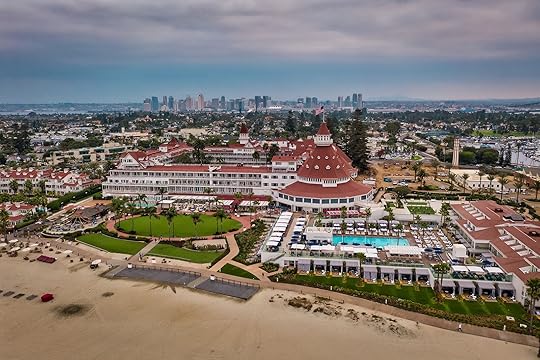
Photo: Manuela Durson/Shutterstock
Hotel del Coronado is located just across the bay from downtown San Diego. Not only is it a short drive from the airport, bringing you right to the beach in about 20 minutes, but it also provides easy access to popular neighborhoods like the Gaslamp Quarter and Seaport Village in about 10 to 15 minutes by car via the Coronado Bridge. Other attractions, such as the San Diego Zoo and USS Midway Museum, are just a slightly longer drive.
Rideshares are readily available for hotel guests and a great option from the airport if you plan to spend most of your time on the property or nearby. If you want the flexibility to scoot around to different beaches and attractions whenever you want, car rentals are also easy to arrange. You can also reserve bikes (beach cruises, e-bikes, or young adult mountain bikes) via the hotel to get around the property and the area. 
The 5 Coolest Stadiums Hosting 2026 FIFA World Cup Matches

Every four years, the FIFA World Cup draws global attention to its host city and country. And in 2026, that attention will be magnified times 16, as a collection of cities ranging from Mexico City to Boston host matches over a five-week period. Each city is bound to get lots of airtime, but the one building in each city that will get covered the most will surely be its stadium, with each hosting anywhere from five to eight matches.
Each stadium on the roster reflects a blend of local identity and modern design, from the open-air marvel of SoFi Stadium near LA to the art-filled AT&T Stadium in Texas. Estadio Azteca in Mexico City is set to make history as the first stadium to host three World Cup opening matches, and Vancouver’s BC Place is bound to put on a nighttime show covered across the world on its exterior, coated with millions of multi-colored lights.
As fans prepare to descend on these cities, the stadiums themselves are poised to be as much a part of the experience as the World Cup matches they host. These are five of the coolest World Cup venues set to take center stage in 2026, in case you’re keen to travel for the matches but haven’t quite decided exactly which city — or cities — you want to visit.
Tickets have not yet gone on sale, but you can register your interest in all 16 cities by signing up at this link.
SoFi Stadium, near LA
Photo: SoFi Stadium
SoFi Stadium is a design and engineering marvel. Its most notable feature is a single-layer durable plastic roof that just happens to be completely translucent. It stretches over the field and seating bowl while remaining open at the sides. It actually functions as a projection surface, and jets flying into LAX can looks down onto the giant message board. For guests at the stadium, it lets plenty of light in while blocking some UV rays. There’s also huge 360-degree, HDR video board hanging over the middle of the field, shaped like a giant loop with screens viewable on all sides. It ensures every seat in the stadium can see the action, even in the upper tiers.
And speaking of views: you won’t miss the action if you run out to grab a hot dog, since the concourses are open. And when you’re walking around before and after matches, there’s plenty to see, including large outdoor sculptures near the entrances and green spaces around the stadium, and an art gallery inside the stadium. In the past, it’s hosted exhibitions on African American art and history to partnerships with local art galleries. There are also lots of murals in Hollywood Park, the mixed-use space around SoFi stadium. No word yet on what exhibits will be on display during the World Cup.
Mercedes-Benz Stadium, Atlanta
Photo: Mercedes-Benz Stadium
In Atlanta, Georgia, is Mercedes-Benz Stadium, one of the coolest World Cup venues. It has an eight-panel retractable roof that functions like a camera aperture as it opens and closes. It’s the first roof of this type in the world and can open and close in about 10 minutes, making it a fascinating thing to watch. Inside, Mercedes-Benz Stadium has the largest video board of any sports stadium in North America, so it’s one of the best venues for watching a match if you’re only willing to spring for seats in the back.
One feature you’ll definitely notice inside the stadium is the “window-to-the-city” wall on one side. It’s a floor-to-ceiling window that covers multiple concourses and looks out on downtown Atlanta. It gives the whole stadium a modern look, which isn’t surprising, considering it just opened in 2017. It’s also one of the most sustainable World Cup Stadiums, with more than 4,000 solar panels on the exterior and a rainwater capture system to reduce water consumption.
Estadio Azteca, Mexico City
Photo: Aleksandr Medvedkov/Shutterstock
Estadio Azteca (recently renamed Stadium Banorte) in Mexico City is one of the most iconic and historically significant World Cup venues. It was the first venue to host two FIFA World Cup finals (in 1970 and 1986) and remains the only stadium where both Pelé and Maradona lifted the World Cup trophy. With a capacity of around 87,000, it’s the largest stadium in Latin America, and at an elevation of 7,200 feet above sea level, it’s known for being one of the more physically taxing stadiums to play in.
Architecturally, it’s both massive and brutalist, designed by two prominent Mexican midcentury architects. design. Built into the lava plains of Mexico City’s Coyoacán district, the stadium’s concrete structure was engineered by Pedro Ramírez Vázquez and Rafael Mijares Alcérreca—two of Mexico’s most prominent mid-century architects. The shape and steeply tiered stands give it a coliseum-like appearance, while the open-air design and sunken field area enhance visibility and acoustics — it’s often defined as deafening. There’s not a bad seat in the house, and it was one of the first ever to be constructed without interior pylons, ensuring no one has a blocked view.
The stadium has undergone recent renovations to prepare for 2026, including upgrades to seating, lighting, media facilities, and circulation. The museum inside the stadium has exhibits on Pelé, Maradona, and guided tours are available on days where there aren’t matches or events in the stadium. With a capacity of just over 83,000, it’s tied with NY/NJ for having the largest size of any World Cup venue.
BC Place, Vancouver
Photo: Josef Hanus/Shutterstock
BC Place in Vancouver borrows features from many of the best stadiums in the world, with a roof that opens somewhat like the one in Mercedes-Benz Stadium, and a translucent panel roof, like in LA. These designs also eliminate the need for internal columns, meaning every seat in the stadium is a good one. Less visible but equally fascinating is the on-site BC Sports Hall of Fame, a permanent, publicly accessible museum dedicated to the history of sport in British Columbia, with memorabilia displays and interactive elements. Within it is the Indigenous Sport Gallery, celebrating First Nations athletes, often left out of mainstream sporting narratives.
Another unique element about BC Place is that the exterior functions as a city-wide display board. The lighting is programmable in millions of color combos and frequently used for public events and campaigns. It’s usually illuminated most evenings until around 11 AM in Northern Lights-inspired colors, but it could be glowing in white and red during the World Cup matches in support of the country’s many players fielding teams in 2026.
AT&T Stadium, near Dallas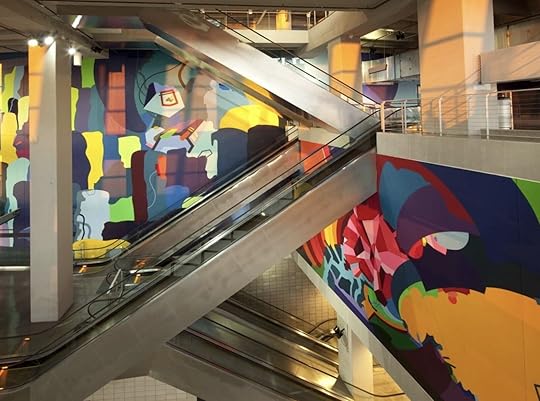
Photo: AT&T Stadium
AT&T Stadium in Arlington, Texas, is unusual among major sports venues in that it has a formal modern art program on site. It was spearheaded by the owners of the Dallas Cowboys and includes more than two dozen large-scale works by internationally recognized artists like Olafur Eliasson, Anish Kapoor, Doug Aitken, and Jenny Holzer — artists whose work is typically found in major museums, not sports venues. Pieces are scattered throughout the club areas, in suite levels, on the concourses, and even in stairwells. The intent is to make the art accessible to the general public, rather than limiting it to VIP areas, so there’s no dedicated gallery space.
The stadium offers art-focused tours through the collection, and near each piece are interpretive materials and QR codes with background on the artist and the art. The program was developed in partnership with the Public Art Program of North Texas, and is sort of like a privately funded version of a percent-based public art program. Few World Cup venues focused on sports consider art a vital component of the visitor experience, making AT&T Stadium a rare treat for people interested in sports and artistic culture. 
In a 35-Year First, the Best Beach in the US Isn’t in Hawaiʻi or Florida

For the first time in 35 years of ranking beaches, data from Dr. Stephen Leatherman — a.k.a. “Dr. Beach” — awarded the title of “America’s best beach” to one outside of Hawaiʻi or Florida.
Coopers Beach in Southampton, New York, earned the number one spot for 2025. It’s a shift for the list, historically dominated by the tropical (and subtropical) sands of the Pacific and Gulf coasts. Coopers Beach is beloved for its broad stretches of grainy white sand, towering dunes covered in swaying beach grass, and backdrop of Hamptons mansions — though it isn’t immune from criticism, as parking there costs $50 per day. But it finally edged out perennial favorites after taking third place in 2023 and second place in 2024. Now, it’s the best beach in the US, according to 50 rigorous data points.
Since 1991, the beach expert has assessed beaches on 50 distinct criteria, from water temperature and sand softness to wave quality, cleanliness, noise, and amenities like lifeguards and restrooms. Beaches earn “bonus points” for factors like being smoke-free. It’s an in-depth process that ensures beaches can’t rest on their laurels, as environmental setbacks or safety issues can quickly knock previous winners out of the top spots.
2025’s best beaches had some unexpected inclusions
Photo: Joe Trentacosti/Shutterstock
The 2025 list of the best beaches in the US is significantly different from years past (though still geographically diverse). Hawaiʻi still has four entries, and Florida still has two, but other top spots went to more northern beaches, including two in the Hamptons and one in South Carolina. Interestingly, not a single beach in California made the top 10 list. Dr. Beach told CNN that Coronado Beach, which took the 10th spot in 2024, was dropped due to water quality issues stemming from cross-border pollution in the Tijuana River. Other beaches that made the top 10 list in 2025 but were absent in 2025 include Duke Kahanamoku Beach in Oʻahu, Hawaiʻi, and Caladesi Island State Park in Clearwater, Florida.#10: Coast Guard Beach: Eastham, Massachusetts (Ranked #9 in 2024)#9: Lanikai Beach: Oʻahu, Hawaiʻi (Not on 2024 list)#8: Kaunaoa Beach: Big Island, Hawaiʻi (Not on 2024 list)#7: St. Andrews State Park: Panama City, Florida (Not on 2024 list)#6: Beachwalker Park: Kiawah Island, South Carolina (Ranked #5 in 2024)#5: Main Beach: East Hampton, New York (Ranked #6 in 2024)#4: Delnor-Wiggins Pass State Park: Naples, Florida (Ranked #8 in 2024)#3: Poipu Beach: Kauaʻi, Hawaiʻi (Ranked #7 in 2024)#2: Wailea Beach: Maui, Hawaiʻi (Ranked #3 in 2024)#1: Coopers Beach: Southampton, New York (Ranked #2 in 2024)2024 vs 2025’s list

St. Andrews State Park is known not just for the beach, but for its surrounding protected wildlife habitat. Photo: Terry Kelly/Shutterstock
Dr. Beach uses the same criteria each year, so the metrics don’t change. However, the score each beach gets in every category can change — for example, a popular beach could score highly on the “noise” factor if having lively surroundings is considered a good thing, but get a low score another year if there’s more of a general desire for peace and quiet. The 2025 winners reflect some general trends also reflected in travel across the US.
The fact that there were four beaches in Hawaiʻi, and two that are less commercialized and more tranquil (Kaunaoa and Lanikai) suggest that travelers are trending toward more secluded and natural beaches. Both Delnor-Wiggins Pass and Beachwalker Park are wildlife conservation areas, and in St. Andrews State Park, visitors have to take a ferry to reach the main part of the park, helping to keep development (and some crowds) a bit removed. 
May 24, 2025
The Best Hotels Near Houston’s NRG Stadium for Soccer Fans

Houston will host seven matches during the FIFA World Cup 2026, including two in the knockout stages. That means soccer fans from around the world will be descending on this Texas giant — and if you’re one of them, sorting out where to stay should be near the top of your to-do list.
NRG Stadium is in the south of Houston, around 20 minutes from downtown by car or public transportation. This area is home to the Texas Medical Center, so although it’s well-connected, it’s not exactly picturesque — and most of the walkable hotels nearby are practical two- or three-star stays. That said, the Red Line light rail connects central Houston to the Stadium Park/Astrodome Station, so realistically, you can stay anywhere in downtown or Midtown and ride in for fixtures in about 30 minutes.
Accommodation options range from walkable stadium-adjacent hotels to downtown stays with easy light rail access. Several may offer shuttle services on game days (though that’s still unconfirmed at time of writing, so check directly when booking). These are the best places to stay for fixtures at NRG Stadium during the World Cup.
We hope you love the hotels near NRG Stadium we recommend! Just so you know, Matador may collect a small commission from the links on this page if you decide to book a stay. Listed prices are accurate as of the time of publication.
The best hotels near hotels near NRG StadiumComfort Suites
Photo: Booking
Location: East of, 1055 McNee Road, Main St, HoustonHow far from the stadium: 12-minute walkPrice: From $72 per nightFor a no-frills stay within walking distance of the stadium, Comfort Suites off McNee Road is a 12-minute stroll — making it one of the most convenient budget-friendly options near NRG. It’s a straightforward setup: clean, spacious suites with microwaves and mini-fridges, and a free hot breakfast that includes a DIY waffle station previous guests shout out in reviews. The beds are comfortable, and if all you need is a place to crash after a big day, it works. You’ll find a fitness room and a seasonal outdoor pool on site, but most people stay here for proximity. Rates fluctuate, but it’s likely you’ll get a room for around $100 if you book soon.
BookFour Seasons Hotel Houston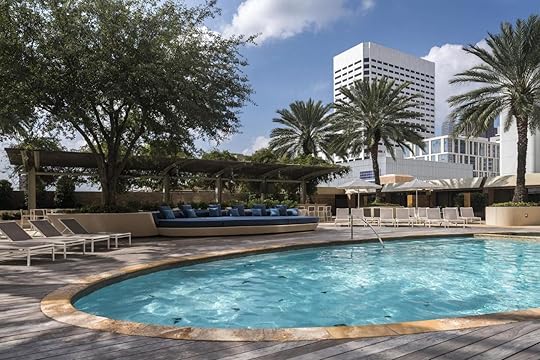
Photo: Booking
Location: 1300 Lamar St, HoustonHow far from the stadium: 17-minute drive, or 40-minutes on the Red LinePrice: From $454 per nightIt’s quite a leap to go from the Comfort Suites to the Four Seasons, but if you’re planning to shape your World Cup stay around more than just the match, the five-star makes a very compelling case. It’s under a 20-minute drive from NRG, but the hotel’s mix of over-the-top service and curated indulgences makes the extra distance feel negligible. Bayou & Bottle, the hotel’s bourbon bar and dining space with over 100 labels and a built-in Topgolf simulator, is located on the main level, and Bandista, a reservations-only speakeasy hidden behind a bookcase, ranks among the city’s hardest-to-book cocktail bars. Rooms are oversized, with leather headboards, warm wood tones, and photography that references the city’s western heritage. The rooftop pool is ringed with palm trees, and you could easily spend a few day without leaving property between the spa, grab-and-go café, and chef Richard Sandoval’s steakhouse. If you’re going big for the World Cup — or someone else is footing the bill — this is where to stay.
BookHoliday Inn Houston S
Photo: Booking
Location: 8111 Kirby Dr, HoustonHow far from the stadium: Seven-minute walkPrice: From $103 per nightIf being steps from the stadium is your top priority and you don’t mind a Holiday Inn stay, this property is less than a ten-minute walk to NRG. It’s straightforward, practical, and surprisingly spacious — rooms come with minifridges, microwaves, and Keurigs, with layouts that can accommodate small groups or families. There’s a well-lit desk setup if you’re juggling work between matches, and the on-site restaurant has served as a fallback for previous travelers when nearby spots are packed. It’s not flashy, but the location alone might tip the scales in its favor.
BookHyatt Regency Houston Downtown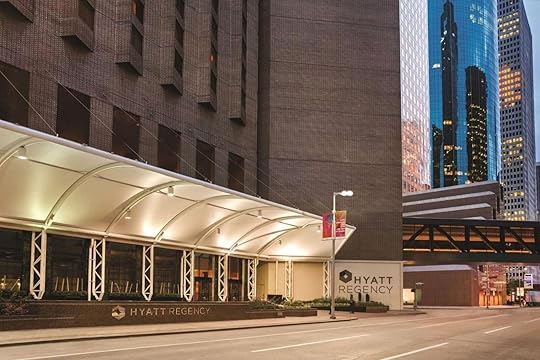
Photo: Booking
Location: 1200 Louisiana St, HoustonHow far from the stadium: 17-minute drive, or 40-minutes on the Red LinePrice: From $161 per nightStaying downtown means trading a short trip to NRG for a lot more to do between matches and at the Hyatt you’re within walking distance of must-see sights like Discovery Green and Minute Maid Park. Room types range from simple doubles with skyline views to a two-story Grand Suite with a spiral staircase and a dining area that seats a large group. Gulf & Prairie is a great place for dinner with crab-stuffed snapper, brisket mac and cheese, and a barbecue platter stacked with beef and pork sausage, ribs, and brisket. Fixin’ To Go offers quick delivery from the same kitchen, with orders placed by phone and brought straight to your room. And the sixth-floor pool deck offers a quiet place to cool off, with open-air views of downtown.
BookLa Colombe d’Or Hotel
Photo: Booking
Location: 3410 Montrose Blvd, HoustonHow far from the stadium: 13-minute drivePrice: From $378 per nightThis boutique stay in Montrose puts you in one of Houston’s most vibrant neighborhoods, a short drive from NRG Stadium and even closer to the city’s top museums. Set in a restored 1920s mansion, the 32-suite property features heritage architecture, contemporary amenities, and an on-site collection of more than 400 original artworks. A rooftop pool on the 10th floor offers sweeping views of downtown, while the French brasserie, Tonight & Tomorrow, serves dishes like trout almondine, Texas stuffed quail, and Akaushi beef burgers, with outdoor seating in the sculpture garden. It’s one of the city’s few five-star hotels in a neighborhood that delivers on food, culture, and character.
BookOmni Houston Hotel
Photo: Booking
Location: 4 Riverway Dr, HoustonHow far from the stadium: 15-minute drivePrice: From $123 per nightA World Cup trip is a pretty good excuse to upgrade your stay — and if you’re looking for something upscale but not downtown, the Omni Houston offers a comfortable retreat in the Uptown area, just a 15-minute drive from NRG. It’s close to The Galleria and a handful of other high-end shopping and dining areas, with Memorial Park and its golf course just up the road. The property is spread out but doesn’t feel corporate, with floor-to-ceiling windows looking out over quiet gardens and shaded walkways. Rooms have a warm, neutral palette with oversized beds and deep-soaking tubs, and there’s a two-floor wellness space that includes a spa, gym, and full-service salon. If you don’t feel like calling a rideshare, a complimentary shuttle runs within a three-mile radius — handy for errands or dinner plans. The hotel is also rumored to be a potential team basecamp, which could mean limited availability during tournament weeks — and a good chance of crossing paths with players or staff.
BookThe Laura Hotel, Houston Downtown
Photo: Booking
Location: 1070 Dallas St, HoustonHow far from the stadium: 17-minute drive, or 40-minutes on the Red LinePrice: From $167 per nightSet in a former skyscraper near the heart of the Central Business District, The Laura is a four-star stay that’s quieter than the big-name chains but still holds its own when it comes to design, dining, and location. It’s around a 20-minute drive to NRG Stadium, but in exchange, you’re steps from the Theater District, the Toyota Center, and a growing cluster of bars and restaurants. Rooms are bright and thoughtfully decorated, with marble bathrooms, soaking tubs, and floor-to-ceiling windows that showcase the skyline. Hull & Oak, the hotel’s Southern restaurant, serves dishes such as crab cake-stuffed avocado, country-fried chicken with bacon-braised collards, and one of the better short rib plates in town. The rooftop pool and spa are easy to spend time in between fixtures, and on Friday nights, live music at the lobby bar makes it a decent post-match drink spot.
BookThe Post Oak Hotel
Photo: Booking
Location: 1600 W Loop S, HoustonHow far from the stadium: 13-minute drivePrice: From $504 per nightThere’s no shortage of high-end hotels in Houston, but The Post Oak promises a stay to remember. Step through the lobby and you’re met with a ceiling-high chandelier, museum-grade artwork, and a sleek showroom that casually houses a Rolls-Royce or two. It’s under a 15-minute drive to NRG Stadium, and while you won’t be walking to the match, you will be surrounded by restaurants, designer shopping, and more Bentleys than you’ll see anywhere else in the city (there’s also a dealership in the building). Standard rooms are oversized and meticulously outfitted, with his-and-hers robes, slippers, and small details you didn’t know you needed — like logo flip-flops for the pool. The spa is one of the best in Houston, with everything from body-contouring loungers to bento boxes for a post-treatment snack. Dining ranges from Gulf seafood at Willie G’s to lavender ice cream and lemon olive oil cake at Bloom & Bee, with pastry chef Oralia Perez’s desserts worthy of a visit even if you’re not staying here. It’s a splurge, but if your budget allows, the level of comfort and service is hard to beat.
BookThe Westin Houston Medical Center — Museum District
Photo: Booking
Location: 1709 Dryden Rd, HoustonHow far from the stadium: Seven-minute drivePrice: From $158 per nightThe Westin Houston Medical Center is less than a 10-minute drive from NRG Stadium and offers more than you’d expect at this price — including one of the better outdoor pools near the venue. It’s located along the METRORail Red Line, with easy access to Rice University, the Houston Zoo, and some of the city’s best museums. Rooms are clean and modern, with Westin’s signature beds, rainfall showers, and generous workspace if you’re trying to juggle emails between matches. The pool deck sits alongside Terrace 54, where you can order dishes like Calabrian chili wings, a grilled BLT with smashed avocado, and cocktails like the Mezcal Pineapple Sour or the gin-and-elderflower “Sunshine on Dryden.” If you’re planning to be in town during the summer games, the pool and rooftop will make this a popular choice, so it’s worth booking early.
BookWingate Houston near NRG Park
Photo: Booking
Location: 8600 Kirby Dr, HoustonHow far from the stadium: 16-minute walkPrice: From $86 per nightThis no-frills option is walkable to the stadium — about 15 minutes on foot — and priced for those who are here for the match, not the minibar. Rooms are basic but functional, with microwaves, mini-fridges, and coffee makers. There’s a fitness room and a heated outdoor pool with a large sun deck, which will be welcome in Houston’s summer temperatures. Breakfast is included, and the waffle maker sees a lot of action on match mornings. You won’t find much nightlife nearby, but you will find a clean, budget-conscious stay within walking distance to your seat.
BookWyndham Houston near NRG Park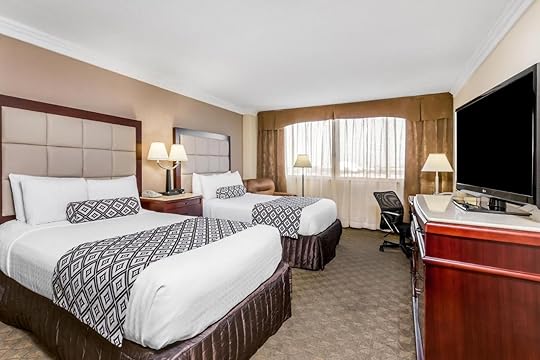
Photo: Booking
Location: 8686 Kirby Dr, HoustonHow far from the stadium: 13-minute walkPrice: From $102 per nightIn all honesty, this wouldn’t be my top pick — especially if you’re planning to hang around the property — but if walking to the stadium is non-negotiable and you’re only in town for a night or two, Wyndham Houston near NRG Park gets the job done, and rates tend to stay lower than those at nearby chains. It’s about a 13-minute walk to NRG, and while the dated interiors won’t win design awards, there are nearly 400 rooms, free parking (except during major events), an on-site bar called Cattleman’s Club, all-day diner-style staples at Stetson’s restaurant, and a gift shop, which stocks snacks if you’re heading back late. Rooms vary — some have updated bedding, others still feel a bit stuck in time — but for those focused on catching the match and crashing close by, that might not matter. 
May 23, 2025
What to Know About the High-Tech US National Soccer Hall of Fame

Frisco, Texas, may not get the tourist attention of other destinations in Texas like Dallas, Big Bend National Park, or even quirky Marfa. But for fans of soccer in the US, it’s an unbeatable place to visit — because it’s home to the sprawling and impressive US National Soccer Hall of Fame. It’s a packed exhibition space functioning as half museum, and half permanent display to honor the sport’s biggest changemakers.
How the National Soccer Hall of Fame was born
A photo of early women playing soccer, circa 1910-1920. Photo: Library of Congress/Public Domain
The National Soccer Hall of Fame is the most significant institution in the US for honoring the growth and history of soccer in the US. While America’s love for soccer may not be as widespread as other countries in the world, it’s quickly growing, especially as Major League Soccer expands into more and more cities.
The history of the museum begins in 1950, when the interest in soccer in the US was regional and minimal, at least compared to other sports. Only groups like the Philadelphia Old Timers’ Association, made up of former players and soccer supporters, were recognizing soccer achievements or even chronicling its history. While their efforts were informal, they were the beginning of the ideas that American soccer was noteworthy and deserved to be celebrated.
This early effort was informal, but it established the principle that American soccer’s history deserved to be preserved and celebrated. And by 1953, the The US Soccer Football Association had grown large enough to begin undertaking that project on a national level. For decades, it maintained a list of honorees and a collection of US soccer memorabilia, but it didn’t have any type of permanent location to display everything.
But in 1979, there was a major turning point: the Hall of Fame opened its first permanent location in Oneonta, New York. The idea was to use the museum to boost tourism and civic pride in the small town. It was a relatively small museum, but expanded over time, eventually opening a much larger facility with exhibition galleries, a research library, and interactive areas in 1999 — the same year the US hosted the FIFA Women’s World Cup. It had everything from records on the history of US soccer to early World Cup uniforms and championship trophies.

The new-ish Soccer Hall of Fame in Texas. Photo: National Soccer Hall of Fame
However, the remote location kept tourism lower than organizers hoped for, and it ran into funding challenges. It closed in 2010, with nearly everything going into storage until 2018, when it re-opened in Frisco, Texas. It’s now a partnership between the Hunt family, which owns the FC Dallas Major League Soccer team, and the US Soccer Federation.
The Oneonta museum played a crucial role in raising the profile of the Hall and the sport itself. Its galleries featured a chronological timeline of American soccer, tracing the sport’s development from the late 19th century through the rise of professional leagues and the increasing prominence of the U.S. national teams. The museum’s collection grew to include jerseys, trophies, medals, and personal memorabilia from some of the sport’s most influential figures. Notable items included game-worn uniforms from World Cup matches, early league championship trophies, and artifacts from the 1999 FIFA Women’s World Cup, which marked a watershed moment for the sport in the United States. The museum also served as a hub for research, with its library and archives supporting scholarship on the history of soccer in America.
Despite its successes, the Oneonta location faced persistent challenges. The city’s remote location limited visitor numbers, and the Hall struggled to secure sustainable funding. By the late 2000s, financial pressures forced the Hall’s leadership to make difficult decisions about its future. In 2010, the museum closed its doors, and the Hall’s collections were placed in storage. For nearly a decade, the Hall of Fame existed only as an honorary list and an archive, with its artifacts inaccessible to the public.
What to expect at the US Soccer Hall of Fame
Photo: National Soccer Hall of Fame/
The new Frisco facility isn’t just a museum. It’s a 19,000-square-foot space within Toyota Stadium, home of FC Dallas. That means it’s a lively place, where history is both chronicled and being made. It’s a relatively new and high-tech museum, with interactive elements starting from the first steps. Most people spend about 90 minute to two hours in the packed museum, or maybe a little longer if you want to play with all the interactive elements. The museum’s main gallery has a walk-through timeline chronicling the sport’s growth in the US, from its informal roots in the late 1800s to its multi-million dollar industry today. Expect to see photographs, newspaper clippings, and original equipment from more than 125 years ago.
Must-see exhibits and displays
Photo: National Soccer Hall of Fame/
The National Soccer Hall of Fame has more than 400 artifacts, but there are some you want to absolutely make sure you don’t miss. That includes the actual FIFA Women’s World Cup trophies from team USA’s victories in 1991, 1999, and 2015, as well as the original Dewar Cup trophy, commissioned in 1912 and one of the oldest trophies in US sports. You’ll also find Pelé’s autographed New York Cosmos jersey and credentials from rookie 1975 season in the US, as well as more recent memorabilia like Alex Morgan’s and Landon Donovan’s captain’s armbands, or Michelle Akers’ 1996 Olympic credentials.
Other standout pieces include the 1996 Women’s Olympic debut game ball, a telegram from President Calvin Coolidge congratulating the US Men’s National Team after its first Olympic appearance in 1924, championship rings, rare soccer balls, and a championship metal from 1899 (the oldest artifact on display). But there are also plenty of current displays, like memorabilia and bid materials from the upcoming 2026 World Cup. well as United 2026 World Cup bid books and memorabilia from the announcement of the joint North American World Cup.
One of the Hall of Fame’s coolest exhibits is the collection of historic jerseys and memorabilia, including vintage uniforms and original tickets from the league’s colorful 1970s heyday. Don’t miss the scarf wall at the entrance, where you’ll find hundreds of scarves from clubs and national teams around the world.
Soccer Hall of Fame honorees
The Hall of Fame hosts an annual induction ceremony. Photo: National Soccer Hall of Fame
Like most national sports halls of fame, The National Soccer Hall of Fame’s primary mission is to recognize and honor players and industry professionals who have significantly impacted the sports in the US. Honorees are divided into players, veterans, and builders. Veterans need to have been retired for at least 10 years, while “builders” includes anyone who helped build the sport, like coaches, refs, owners, and more. Honorees must be voted in, and include legendary athletes like Mia Hamm, Landon Donovan, Abby Wambach, Clint Dempsey, and Lamar Hunt, who helped build many of the major MLS stadiums around the country.
The entire museum is known as the “Hall of Fame,” with the displays and information on inductees woven into the displays and exhibits.
Interactive elements
Photo: National Soccer Hall of Fame
When entering, guests can use optional facial-recognition kiosks to personalize their tour and select their favorite teams, positions, or players to guide them through the museum. Throughout the various rooms and exhibits, those preferences will be used to make recommendations about what they’d like to see. After a quick scan at check-in, the system will tailor digital displays to reflect your personal preferences, like showing content related to your favorite MLS team across more than 400 digital screens throughout the Hall of Fame.
Touchscreen stations let visitors build their own all-star dream teams and compare player stats, while the “Skills Challenge Zone” lets you try three timed challenges: a shot test to measure how hard you can kick, a reaction test to see if you could make it as a pro goalkeeper, and an agility course with intricate foot work. There’s also a VR penalty kick game, where you’ll don a VR headsets and see if you’re able to guard against real shots taken on players during iconic games in the history of US soccer.
However, the VR elements are totally optional, so visitors who would rather have a traditional museum-type visit can certainly do that, too.
Tickets and pricing
Photo: National Soccer Hall of Fame
While you don’t need to buy tickets to the National Soccer Hall of Fame in advance, it’s recommended, especially match days when FC Dallas is playing (or if there’s another special event). Tickets are easy to buy online and sometimes bundles with FC Dallas tickets if you’re interested in both. Walk-up tickets are usually find on weekdays or on days when no events are in the stadium.
The National Soccer Hall of Fame’s schedule changes daily and is posted online, but it’s generally 1PM to 9PM on Wednesdays, 1:30 PM to 5PM on Thursdays and Fridays, 10AM to 5PM on Saturdays, and noon to 5PM on Sundays. It’s closed Monday and Tuesday, but may eb closed on additional days for private events.
Ticket are $15 for adults, and $12 for kids ages 5-12, seniors, or military and first responders. Kids three and under are free. On-site parking is free, and the drive from Dallas takes about 35 minutes. 
May 22, 2025
United Airlines Announces the Start of 17 New International Flight Routes

Late last year, United Airlines announced its biggest international push in decades, charging into 2025 with the most aggressive expansion in its history. It shared plans to revamp both its physical assets and fleet, as well as its global network to cement its position one of, if not the, biggest international airline based in the US. According to news sources, the airline’s strategy is twofold: refresh its aircraft lineup under what it calls the “United Next” initiative, and roll out a wave of new international routes — many of which are to cities other US carriers aren’t serving. While some new routes were new, a handful are complete surprises.
Now, those new routes are starting to roll out to passengers, with most starting in July 2025.
M
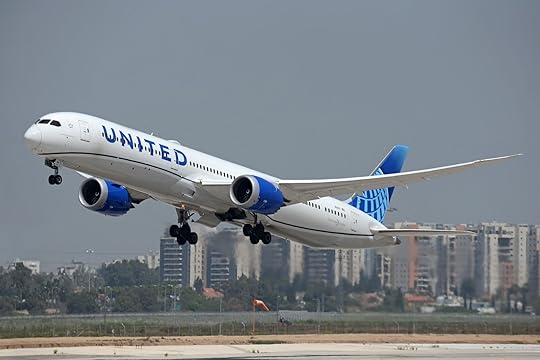
United is buying dozens of new planes, including many large Boeing Dreamliners. Photo: Felix Tchvertkin/Shutterstock
One of the major parts of United’s new growth strategy is a massive upgrade to its planes. In 2025 alone, the airline expects to bring 135 new aircraft into service, ranging from Boeing Dreamliners to narrow four-seat-across jets for shorter hauls. These newer jets will gradually replace older planes like the 737-700s and the A319s, with the new planes having both better fuel efficiency and nicer interiors.
For longer international hauls, the airline plans to roll out more than two dozen Boeing 787 Dreamliners in 2025, accelerating the phase-out of aging 767s and 777s. The much-delayed Airbus A350s also remain in the pipeline, though deliveries aren’t expected to begin before 2030. All the new planes will have modern upgrades like Bluetooth-enabled seatback screens (which some United planes already have), power outlets at every seat, and high-speed Wi-Fi via Starlink. (However, ongoing delays at Boeing make it unclear whether United will actually receive all of its scheduled deliveries on time.)
United adds more international routes
Remote Regina, Canada, is now accessible via United Airlines. Photo: Creative bee Maja/Shutterstock
United also rolled out 17 new routes, with 800 daily international departures to 147 destinations across the planet — more than any other airline based in North America. Many of the new routes will be served by some of the smaller planes United plans to buy. “There is an extensive list of potentially successful routes that don’t have quite as much depth in demand,” said Patrick Quayle, the airline’s SVP of global network planning, on LinkedIn. Smaller planes allow United to offer new routes that may not have enough demand to fill larger planes. He gave the example of Ulaanbaatar, Mongolia, which is now reachable on United via Tokyo.
Here are some of the most exciting new routes, most of which are connected through United’s biggest hubs: Newark, San Francisco, Houston, and Washington, DC.
Europe: United is adding new flights to Faro and Madeira in Portugal; Palermo in Sicily; Bilbao in Spain; and expanding service to Nice and Venice. The additions will bring the airline’s totals to five destinations each in Portugal and Italy, and six in Spain. The Madeira flights will leave from Newark, New Jersey, running three times a week between early June and late September.
Asia-Pacific: New flights to Bangkok, Thailand; and Ho Chi Minh City, Vietnam (both via Hong Kong) will make United the only US carrier serving both cities. It also announced the first-ever non-stop route to Adelaide, Australia, and added extra flights around Manila in the Philippines, Taipei in Taiwan, and Guam, among other destinations.
Africa: United will become the biggest US airline in terms of flights to Africa, introducing a new year-round flight from Washington, DC, to Dakar, Senegal. It already flies to Cape Town, Johannesburg, Accra, Lagos, and Marrakesh.
Warm-weather destinations: United also introduced new nonstop flights from the US to Puerto Escondido, Mexico, and more flights between San Francisco and San Jose, Costa Rica.
Offbeat spots: As Quayle said on LinkedIn, it’s not just the mainstream cities and countries United will fly to. New connected destinations launching in 2025 will include Nuuk, Greenland; Ulaanbaatar, Mongolia; and Regina, Canada. All three are destinations that are difficult to reach on other US-based airlines. 
The Best Bars in Guadalajara to Watch the 2026 World Cup

Guadalajara’s Colonia Americana neighborhood is the best area to do a World Cup pub crawl. Within a half-mile of Av. Chapultepec Sur, dozens of bars and restaurants will be showing the matches. But even if you aren’t staying the that neighborhood, you’ll have no problem finding a good bar at which to post up – Guadalajara is a soccer-crazed city that is sure to be rocking throughout the tournament. Here are the city’s best sports bars for watching the 2026 World Cup.
View this post on Instagram
A post shared by Gallo Cervecero (@gallocervecero)
Gallo Cervecero Sportsbar is a standout in Colonia Americana for its trendy yet cozy vibe, excellent beer and cocktail selection, and a menu menu of spruced-up wings and burgers. A room full of screens and a lively crowd make game days especially fun, and its walkable from most spots in Colonia Americana.
Gallo Cervecero Sportsbar: C. Progreso 79, Col Americana, Americana, 44600
SkyGamers Sports BarView this post on Instagram
A post shared by Skygamers Sport Bar GDL (@skygamers.sportbar_gdl)
SkyGamers Sports Bar isn’t messing around – it’s bar is literally ringed with enough TVs to show over a dozen matches at once. The beer is cold, the crowd dedicated to whomever its team may be, and despite being in Centro, just east of Colonia Americana, the bar is walkable from many points in the neighborhood.
SkyGamers Sports Bar: Av. Vallarta 874 entre Camarena y, C. Escorza, Centro, 44100
Señor Stone ChapultepecView this post on Instagram
A post shared by El Señor Stone (@elsenorstone)
Señor Stone offers a classic sports bar experience in Colonia Americana, complete with hearty bar food like ribs and fries, and plenty of screens for watching matches. Sit outside on the patio for some fresh air, or closer to the bar when your favorite team is playing. Its located right on Av. Chapultepec, making it easy to find and reach.
Señor Stone Chapultepec: Av. Chapultepec Sur 129, Col Americana, Americana, 44160
Cerveceria Chapultepec
Photo: Lorenza Ochoa /Shutterstock
Cervecería Chapultepec keeps prices low, and its Avenida Chapultepec outpost places it in the heart of Guadalajara’s vibrant nightlife district. You’ll find DJs on weekends, soccer on TV constantly, and the best beer selection in the neighborhood.
Cerveceria Ghapultepec: Av. Chapultepec Sur 464A, Col Americana, Obrera, 44150
Best bars to watch the World Cup in ProvidenciaLa VitolaView this post on Instagram
A post shared by La Vitola Bar (@lavitolabar)
La Vitola, just across Av. Manuela Avila Camacho from the Guadalajara Country Club, features multiple screens to catch the action and offers great promotions on beer buckets, rounds of shots, and cocktails. The food menu includes snacks, tacos, pizzas, and the typical run of sports bar appetizers.
La Vitola: Av de la Presa, Jardines del Country, 44210
Proyecto CantinaView this post on Instagram
A post shared by Proyecto Cantina (@proyectocantina)
Sports fans in one of Guadalajara’s fanciest areas head to Proyecto Cantina to watch matches over sandwiches and beer. It’s open till at least 1 am, and walking distance (or a short Uber) if you’re staying in the area.
Proyecto Cantina: Colonia, Avenida Circunvalación Providencia No.1083 Entre Calles Mar Mediterráneo, Av. Cvln. Jorge Álvarez del Castillo y, Country Club, 4461
California Wings and BeerView this post on Instagram
A post shared by California Wings And Beer (@californiawingsandbeer)
California-style wings and beers just south of Providencia central are the staple here, with a good vibe that’s easily accessible to those in other neighborhoods in central Guadalajara. The bar stays open late and will have both World Cup and major US sporting events on.
California Wings and Beer: Av. Manuel Acuña 3184, Monraz, 44670
Best bars to watch the World Cup in ZapopanWingman Sports HouseView this post on Instagram
A post shared by Wingman Sport House Providencia – Restaurant Bar (@wingmanprovidencia)
The name says it all – wings, sports, and a homey vibe. Wingman Sports House is just north of the stadium and is sure to be popping off throughout the tournament. If you head to the stadium area to check out the scene but without tickets, come here to watch the game.
Wingman Sports House: Carr. Guadalajara – Tepic 21b, San Juan de Ocotán, 45019 Zapopan
McCarthy’s Irish PubView this post on Instagram
A post shared by McCarthy’s Irish Pub (@mccarthysirishpub.gdl)
About two miles from Estadio Akron, McCarthey’s offers a classic Irish sports bar experience with outdoor seating, multiple TVs, happy hour drink specials, and a menu featuring standard bar food like burgers and wings.
McCarthy’s Irish Pub: Av. Rafael Sanzio #150, Loc.S3-4 A, Residencial, La Estancia, 45020 Zapopan
Cerveceria ChapultepecView this post on Instagram
A post shared by LA CHAPU · GDL (@cerveceriachapultepec)
Cerveceria Chapultepec has multiple locations in and around Zapopan, so wherever you’re staying there’s one not far away. Closest to Estadio Akron is the pub on Av. Patria, and there’s another a few miles northeast of the stadium on Real de Acueducto. Beer, sports, and pub food are on offer at all locations.
Cerveceria Chapultepec: Av. Patria 240, La Estancia, 45030 Zapopan
Rush Sports BarView this post on Instagram
A post shared by RUSH RACING CLUB (@rush_sports_bar)
Rush Sports Bar’s main obsession is auto racing — but during the World Cup passion number two takes the forefront. Expect an international crowd here, in a location that you’ll need to Uber to but that is convenient to those staying at the hotels north of the stadium. 
Rush Sports Bar: Av. Sta. Margarita 3398-Local 9, La Mora, Los Girasoles, 45138 Zapopan
More like thisTravelWhere to Eat, Play, and Stay in Mexico City for the 2026 FIFA World CupMatador Network's Blog
- Matador Network's profile
- 6 followers



